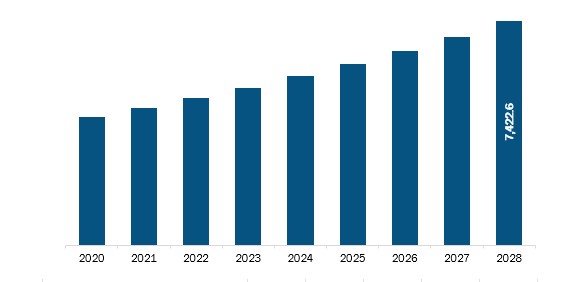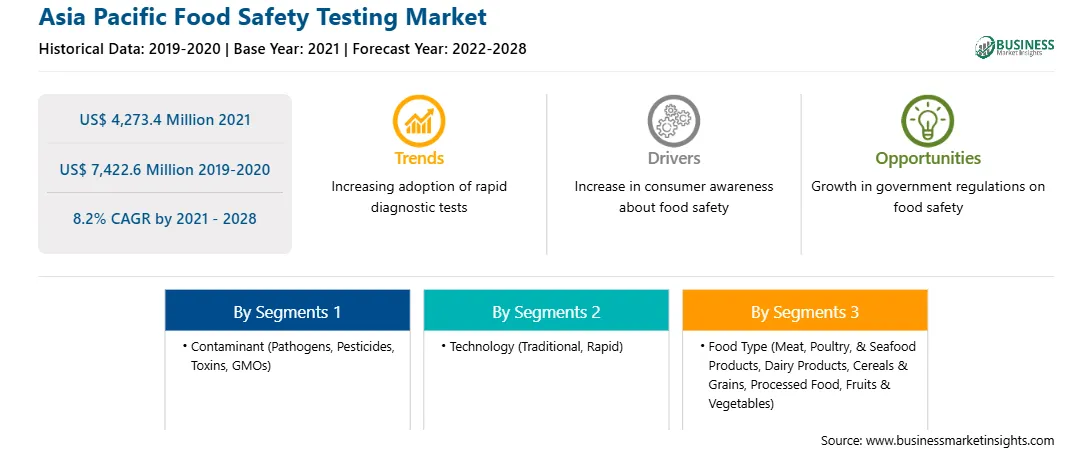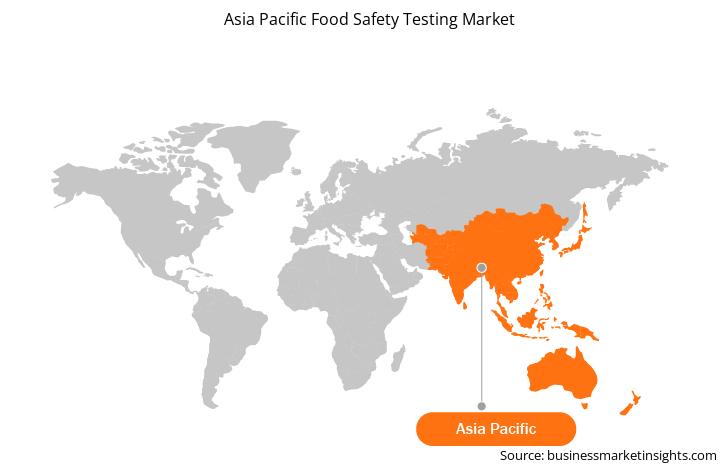Market Introduction
Food safety testing is a scientific analysis of a food product and its contents to find information about various characteristics such as physiochemical properties, composition, and structure. The information is used to determine the safety of the product for consumption. The rising prevalence of foodborne illnesses demands food safety testing for all food and beverage products to prevent health hazards, which boosts the growth of the food safety testing market.
Strategic insights for the Asia Pacific Food Safety Testing provides data-driven analysis of the industry landscape, including current trends, key players, and regional nuances. These insights offer actionable recommendations, enabling readers to differentiate themselves from competitors by identifying untapped segments or developing unique value propositions. Leveraging data analytics, these insights help industry players anticipate the market shifts, whether investors, manufacturers, or other stakeholders. A future-oriented perspective is essential, helping stakeholders anticipate market shifts and position themselves for long-term success in this dynamic region. Ultimately, effective strategic insights empower readers to make informed decisions that drive profitability and achieve their business objectives within the market. The geographic scope of the Asia Pacific Food Safety Testing refers to the specific areas in which a business operates and competes. Understanding local distinctions, such as diverse consumer preferences (e.g., demand for specific plug types or battery backup durations), varying economic conditions, and regulatory environments, is crucial for tailoring strategies to specific markets. Businesses can expand their reach by identifying underserved areas or adapting their offerings to meet local demands. A clear market focus allows for more effective resource allocation, targeted marketing campaigns, and better positioning against local competitors, ultimately driving growth in those targeted areas.
Asia Pacific Food Safety Testing Strategic Insights

Asia Pacific Food Safety Testing Report Scope
Report Attribute
Details
Market size in 2021
US$ 4,273.4 Million
Market Size by 2028
US$ 7,422.6 Million
Global CAGR (2021 - 2028)
8.2%
Historical Data
2019-2020
Forecast period
2022-2028
Segments Covered
By Contaminant
By Technology
By Food Type
Regions and Countries Covered
Asia-Pacific
Market leaders and key company profiles
Asia Pacific Food Safety Testing Regional Insights

Market Overview and Dynamics
The Asia Pacific packaging robots market is projected to reach US$ 7,422.6 million by 2028 from an estimated value of US$ 4,273.4 million in 2021; it is estimated to grow at a CAGR of 8.2% from 2021 to 2028. The major factors driving the market's growth are the growing innovations of food safety testing and the use of whole-genome sequencing (WWGS) in food safety testing in Asia Pacific. However, the high deployment cost of packaging robots hampers the market growth.
Regardless of the restraints posed by the complexity in techniques pertaining to food safety testing, food labs are increasingly developing new and improved testing methods that make the current testing methods quicker and more affordable. The focus on drawbacks associated with several technologies, testing cost, sample utilization, and reducing lead time has resulted in development of new technologies and technological innovation. Greater adoption of these technologies is an opportunity for small and medium-scale laboratories to compete with large market players in the industry and expand their service offerings. These technologies offer non-targeted screening with low turnaround time, multi-contaminant testing, better reliability, higher accuracy in results, and higher sensitivity. The real-time PCR tests give more reliable results since they are more sensitive and provide results within 5–12 hours. ICP-MS can produce high-quality data within a few minutes for elements with a wide range of atomic masses, usually helpful in detecting chemical residue or heavy metals in seafood. NIRS is a rapid testing technology used for the quantitative determination of food constituents in most food items and examine textures without any physical incursion or marker compounds. The machinery required for NMR spectroscopy is expensive; however, the international players involved in food safety testing market are heavily investing in the technology to make it available in regions such as Asia Pacific. Moreover, the ease in supply chain enables food manufacturers to access technology across the globe by sending food samples to obtain accurate results. Also, genome sequencing (WGS) depicts an organism’s complete DNA design, helping food analysts understand variations between and within species. The technology is therefore helping food safety testing market players to differentiate between organisms with utmost precision. Its ability to differentiate between even closely related organisms allows avoidance of additional illnesses and provides the opportunity to stop outbreaks sooner.
The Asian economies have been hit hard due to the COVID-19 pandemic. India recorded the highest number of cases. The emergence of new COVID-19 variants in India, Thailand, and other Asian economies has prolonged the effect of the pandemic upon the food & beverages industry, as the SARS-CoV-2 is highly infectious and could possibly travel through food surfaces. The governments of various Asia Pacific economies are taking possible steps to restrict the spread of the virus by announcing a country-wide lockdown, which directly impacts the growth of the food safety testing market. Meat and poultry processing facilities faced distinctive challenges with respect to the virus as workers in several facilities worldwide were found to be infected. Moreover, in November 2020, China reported that a frozen pork knuckle sample imported from China had triggered a new coronavirus case in China. Such cases of food-related COVID-19 infections have created apprehensions among consumers and governments alike, leading to a greater demand for food safety testing to mitigate health risks.
Key Market Segments
Based on contaminant, the Asia Pacific food safety testing market is segmented into pathogens, pesticides, toxins, GMOS, and others. The pathogens segment is further sub-segmented into salmonella, E. coli, listeria, and others. The pathogens segment would hold the largest market share in 2021; however, the GMOS segment is anticipated to register the highest CAGR during the forecast period.
Based on technology, Asia Pacific food safety testing market is bifurcated into traditional and rapid. The rapid segment is further sub-segmented into PCR-based testing, immunoassay-based testing, and others. The rapid segment is likely to hold a larger market share in 2021 and is expected to grow at a faster CAGR from 2021 to 2028.
Based on food type, the Asia Pacific food safety testing market is segmented into meat, poultry, and seafood products, dairy products, cereals and grains, processed food, fruits and vegetables, and others. The meat, poultry, & seafood products segment would hold the largest market share in 2021; however, the fruits and vegetables segment is anticipated to register the highest CAGR during the forecast period.
Major Sources and Companies Listed
A few market players referred to while preparing the report on the Asia Pacific food safety testing market are SGS SA, Eurofins Scientific, and Intertek Group Plc.
Reasons to buy the report
ASIA PACIFIC FOOD SAFETY TESTING MARKET SEGMENTATION
By
Contaminant
By
Technology
By Food Type
By Country
Company Profiles
The Asia Pacific Food Safety Testing Market is valued at US$ 4,273.4 Million in 2021, it is projected to reach US$ 7,422.6 Million by 2028.
As per our report Asia Pacific Food Safety Testing Market, the market size is valued at US$ 4,273.4 Million in 2021, projecting it to reach US$ 7,422.6 Million by 2028. This translates to a CAGR of approximately 8.2% during the forecast period.
The Asia Pacific Food Safety Testing Market report typically cover these key segments-
The historic period, base year, and forecast period can vary slightly depending on the specific market research report. However, for the Asia Pacific Food Safety Testing Market report:
The Asia Pacific Food Safety Testing Market is populated by several key players, each contributing to its growth and innovation. Some of the major players include:
The Asia Pacific Food Safety Testing Market report is valuable for diverse stakeholders, including:
Essentially, anyone involved in or considering involvement in the Asia Pacific Food Safety Testing Market value chain can benefit from the information contained in a comprehensive market report.